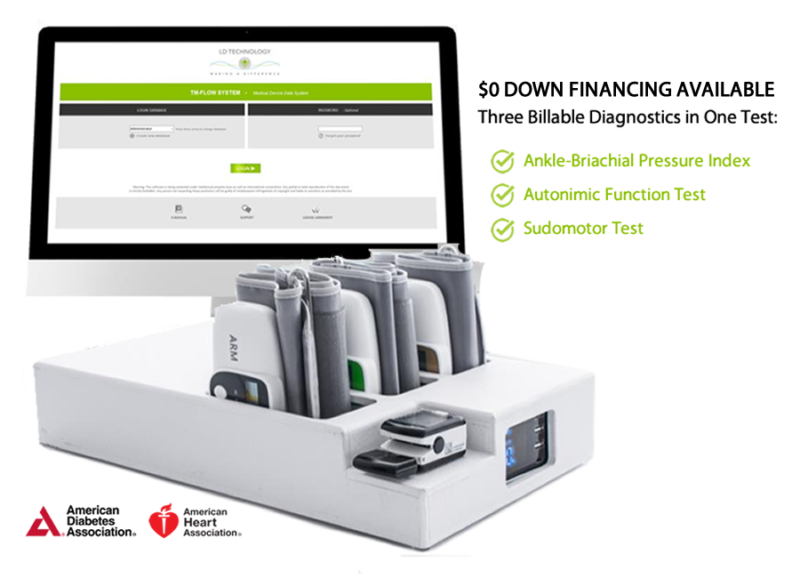Frequently Asked Questions
The TM Flow device offers numerous benefits for medical practices, including non-invasive and accurate testing, early detection of autonomic and arterial dysfunctions, and comprehensive diagnostics that reduce the overall cost of patient care. Additionally, the device’s tests are easy to bill with multi-code diagnostics, making it a valuable investment for enhancing patient care and optimizing practice efficiency. It also supports compliance with standards of care recommended by leading health organizations.
Yes, the TM Flow device is covered by Medicare and most private pay carriers. Specific CPT codes, such as 95921 for cardiovagal innervation and 93923 for ankle-brachial pressure index, ensure that the diagnostics are easy to bill. Coverage and reimbursements may vary depending on the Medicare locality, but the comprehensive diagnostics offered by the TM Flow device are widely recognized and supported by insurance providers.
Autonomic nervous system testing is crucial for diabetes and cardiovascular patients because it helps in the early detection of autonomic neuropathy, which is a common complication in these conditions. Early detection through ANS testing allows for timely intervention and management, reducing the risk of further complications. The American Diabetes Association recommends ANS testing as a standard of care for patients with Type 1 and Type 2 diabetes, highlighting its importance in effective diabetes management.
The TM Flow device is an advanced, non-invasive diagnostic tool designed to perform a series of tests that aid in the identification and early detection of autonomic nervous system (ANS) and arterial dysfunctions. It provides quantitative assessments of the ANS, helping to distinguish between early and late stages of autonomic neuropathy. The TM Flow device is particularly valuable for cardiovascular and diabetic autonomic neuropathy (DAN) testing, making it an essential tool in diabetes management and cardiovascular assessments.
What is peripheral artery disease or PAD? Accumulating plaque on arterial walls is peripheral artery disease. There are risks of peripheral arteries disease. If blood flow to the artery gets obstructed this may result in brain stroke, heart stroke, amputation or ulcerations. These are all very serious conditions.
An ankle brachial index or ABI is a diagnostic tool for peripheral artery disease. The ankle brachial index test is a quick non-invasive way to check your risk of PAD. A low ankle brachial index number can indicate narrowing or blockage of the legs arteries, which increase the risk of circulatory problems, causing heart disease or stroke. A high ankle brachial index number can indicate calcification of the legs arteries, which increase the risk of mortality. The most common symptom of peripheral artery disease in the lower extremities is a painful muscle cramping in the hips, thighs or calves when walking, climbing stairs or exercising.
Emerging evidence now suggests that central blood pressure is better related to future cardiovascular events that is brachial blood pressure. Moreover, antihypertensive drugs can exert differential effects on brachial and central pressure. Therefore, basic treatment decisions on central, rather than brachial pressure, is likely to have important implications for the future diagnosis and management of hypertension.
RSS FEED
- The TM Flow is a highly reimbursable diagnostic in Portland, OR
- Pain Clinics in Albuquerque, NM Adopt the TM Flow as Gold Standard
- Neuropathy in Philadelphia, PA can be detected with the TM Flow device
- Pain Management Clinics in Dallas, TX are Using the TM Flow to Diagnose Symptoms
- Unlocking the Potential of ANS Testing: Insights for Healthcare Providers
- Neuropathy clinics in Savanah, GA use the TM Flow
- Come to Charleston, WV to Get a TM Flow
- How the TM Flow will maximize your physician practice in Boise Idaho
- Doctors in Pittsburg, PA are using the TM Flow for the treatment of neuropathy
- Which Patients Require ANS Testing?
